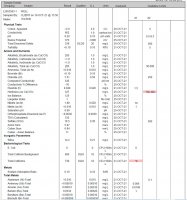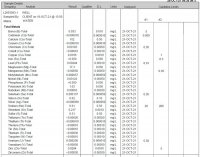Hi all,
Looking for guidance on a water softener. Water Test is attached, details below. I was trying to be brief but realized I’ve probably made the post too long for people to read, but didn’t want to leave anything out… that said, here goes:
I moved into a house about 5 years ago that has a low yielding well, cistern, sediment filter, softener, UV so have done quite a bit of reading on this forum over the past few years. I’m starting to have issues with the ~20 year old existing softener (1.25 cu. ft. Fleck 5600), and it seems undersized for our water hardness and growing family anyway so looking to replace rather than repair/rebuild.
I’ve had the raw well water tested and just got the results today, no iron or manganese and hardness of 19 gpg, which is less than the 26 tested multiple times over the past years with the Hach 5B. Report attached. Surprised at the Coliforms result but we do have the UV. It was originally a dug well that was then drilled deeper so probably gets contamination from surface water. No E. Coli at least.
When I thought the hardness was 26gpg, I was leaning toward a 2.5 Cu. Ft. 5800 XTR2 or XTRi. I was going to go 5810 but have heard that there has been some problems uncovered with that valve that they’re working on.
Everyone who I’ve spoken to locally is recommending a lot smaller unit though, including a Fleck Distributor who builds systems for water techs to buy and install.
Household size: 5 (2 adults, 3 children) Children are very young right now so don’t use much water but want this to work as they get older too.
Water Consumption: Expecting 60 gallons/day x 5 people = 300 gallons/day
Hardness: 19 gpg
Proposed Salt Dose: 8 lbs/cu. ft. Or 20 lbs total
Resulting Capacity: 60,000 grains
Regeneration Frequency: 10.5 days (or 7.7 days if hardness goes back to 26 gpg).. Given no iron or manganese my understanding is we can go as long as 30 days before needing to do a day override in case our water usage right now is way under that.. although based on the 19gpg I feel like 2 cu. ft. would be just fine.
Media Tank: 13” x 54”
Resin: Was just going to go with standard 8%
Desired Maximum Flow Rate: I’m putting a 12 gpm flow limiter on the UV filter as that’s the maximum it can handle (Viqua IHS10-D4)
Water Temperature (for DLFC): 57F
Pressure Tank cut-in/out: 40/60 psi
Questions:
1. Anything wrong with the above, or any other suggestions based on the results?
2. Thoughts on 5800 vs. 5810 valve? I can make the connection 3/4” or 1” as the piping is also being redone.
3. Having some trouble trying to figure out injector size, BLFC, DLFC.. DLFC in particular who people are telling me locally doesn’t really matter
Injector: I think according to dittohead’s catalogue, 2.5 cu. ft. is between #0 red and #1 white, not sure how to decide or pros/cons. Fleck guide for downflow 13” tank appears to be #2 blue.
BLFC: Again according to dittohead’s catalogue, 0.25.. although Fleck guide says 0.5
DLFC: I’m guessing 3gpm? I think that gets me about 40% bed expansion at 57F but not too sure from the charts and the posts. I will put in a top basket but don’t want to rely on that.
4. How much gravel would be recommended? I’m assuming this has to work with the required freeboard and DLFC?
Thanks in advance for any guidance.
Looking for guidance on a water softener. Water Test is attached, details below. I was trying to be brief but realized I’ve probably made the post too long for people to read, but didn’t want to leave anything out… that said, here goes:
I moved into a house about 5 years ago that has a low yielding well, cistern, sediment filter, softener, UV so have done quite a bit of reading on this forum over the past few years. I’m starting to have issues with the ~20 year old existing softener (1.25 cu. ft. Fleck 5600), and it seems undersized for our water hardness and growing family anyway so looking to replace rather than repair/rebuild.
I’ve had the raw well water tested and just got the results today, no iron or manganese and hardness of 19 gpg, which is less than the 26 tested multiple times over the past years with the Hach 5B. Report attached. Surprised at the Coliforms result but we do have the UV. It was originally a dug well that was then drilled deeper so probably gets contamination from surface water. No E. Coli at least.
When I thought the hardness was 26gpg, I was leaning toward a 2.5 Cu. Ft. 5800 XTR2 or XTRi. I was going to go 5810 but have heard that there has been some problems uncovered with that valve that they’re working on.
Everyone who I’ve spoken to locally is recommending a lot smaller unit though, including a Fleck Distributor who builds systems for water techs to buy and install.
Household size: 5 (2 adults, 3 children) Children are very young right now so don’t use much water but want this to work as they get older too.
Water Consumption: Expecting 60 gallons/day x 5 people = 300 gallons/day
Hardness: 19 gpg
Proposed Salt Dose: 8 lbs/cu. ft. Or 20 lbs total
Resulting Capacity: 60,000 grains
Regeneration Frequency: 10.5 days (or 7.7 days if hardness goes back to 26 gpg).. Given no iron or manganese my understanding is we can go as long as 30 days before needing to do a day override in case our water usage right now is way under that.. although based on the 19gpg I feel like 2 cu. ft. would be just fine.
Media Tank: 13” x 54”
Resin: Was just going to go with standard 8%
Desired Maximum Flow Rate: I’m putting a 12 gpm flow limiter on the UV filter as that’s the maximum it can handle (Viqua IHS10-D4)
Water Temperature (for DLFC): 57F
Pressure Tank cut-in/out: 40/60 psi
Questions:
1. Anything wrong with the above, or any other suggestions based on the results?
2. Thoughts on 5800 vs. 5810 valve? I can make the connection 3/4” or 1” as the piping is also being redone.
3. Having some trouble trying to figure out injector size, BLFC, DLFC.. DLFC in particular who people are telling me locally doesn’t really matter
Injector: I think according to dittohead’s catalogue, 2.5 cu. ft. is between #0 red and #1 white, not sure how to decide or pros/cons. Fleck guide for downflow 13” tank appears to be #2 blue.
BLFC: Again according to dittohead’s catalogue, 0.25.. although Fleck guide says 0.5
DLFC: I’m guessing 3gpm? I think that gets me about 40% bed expansion at 57F but not too sure from the charts and the posts. I will put in a top basket but don’t want to rely on that.
4. How much gravel would be recommended? I’m assuming this has to work with the required freeboard and DLFC?
Thanks in advance for any guidance.


